One of my very favorite things to work on in therapy: /s/ blends. May seem random, but I actually do love them so much! /S/ blend speech therapy activities have endless possibilities and you get so much bang for your buck. Wondering what I mean? Keep reading…
Immediate access to all my favorite freebies here:
Why S-Blends Speech Therapy?
Here’s a quick look into my life currently. I have a wild little 3-year-old guy who is wide-open all the time. He is also precious, and sweet, and snuggly, and all those good things too! And, he, like most 3-year-olds, can be hard to understand at times.
Now, since his mama is an SLP, he has already been informally “evaluated,” and his speech is typical for his age. But that doesn’t mean his errors don’t cause some issues at times… For example, one pattern in his speech right now is – cluster reduction, particularly on those tricky /s/ blends. Because I know this, I can understand what he says 99% of the time and can “translate” for him. No big deal, right? Well, my sweet hubby kindly asked if we could maybe work on these sounds the other based on one errored word in particular… The word is “stick.” Now remember, this is our wild, outdoor-loving, all-boy little boy. Stick is a pretty frequent, relevant word for him. Problem is, with his cluster reduction, he deletes the /s/ and vocalizes the /t/… whoops!
See the slight problem? Oh well, we will keep working on it informally but I know will eventually come along… hopefully.
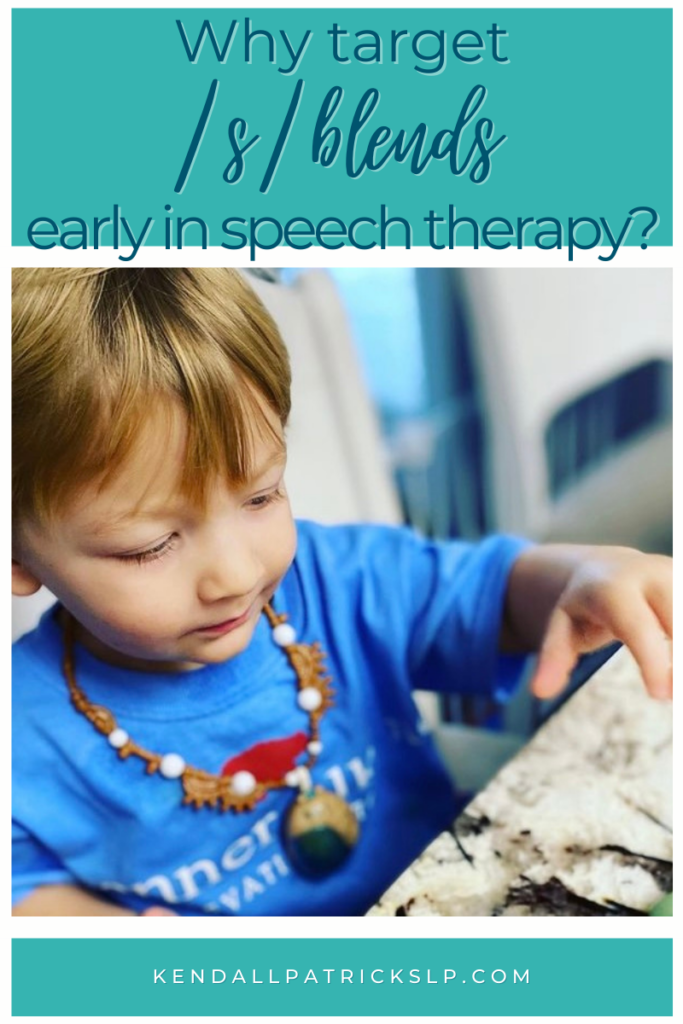
Speech Therapy S Blends Importance
What are /s/ blends? – An /s/ blend is a combination of 2-3 consonant sounds, the first of which is an /s/. In English, these are the initial /s/ blend sounds: ST, SN, SM, SP, SW, SK, SL. The phonological process in which there is a pattern of deleting one of these sounds in speech production is called cluster reduction. Cluster reduction is when a consonant cluster is simplified into a single consonant (e.g., “cool” for “school” or “sick” for “stick”). The average developmental age of elimination for this particular process is 4-5 years of age (source: ASHA). If your child continues to delete a consonant sound in an /s/ blend past this age, you may want to speak with a Speech-Language Pathologist or speak with your doctor about a referral.
To snag some free /s/ blend coloring sheets, check out my free resource library here and click to download the coloring sheets freebie.
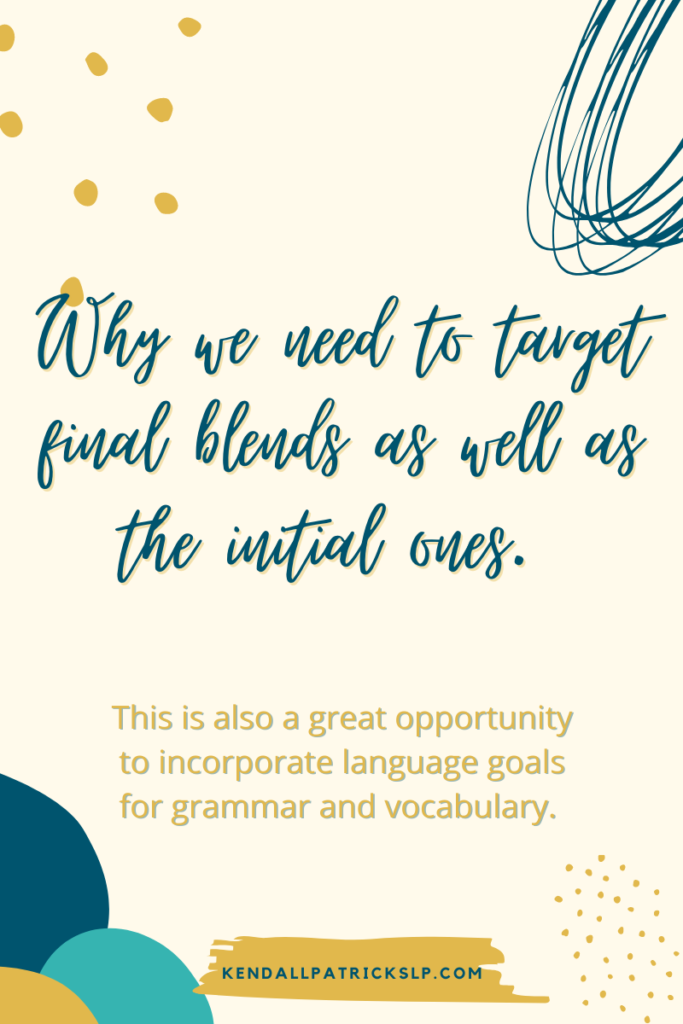
Final S Blends Speech Therapy
There are also final /s/ blends in our language which commonly accur as regular plurals or present tense verbs. For regular plurals, we add an -s to the end in indicate more than one (e.g., “hat” becomes “hats”) and we now have a final /s/ blend (-ts). For present tense verbs (if the subject is third-person singular), we add an -s to the verb (e.g., “jump” becomes “jumps”) and we have another final /s/ blend (-ps).
The common final /s/ blends in English are: TS, PS, KS (e.g., pots, tops, books) + words that end in SK or ST (e.g., mask, best). When targeting /s/ blends it is important to remember all types of /s/ blends and target those final blends as well as the initial ones. This is also a great opportunity to incorporate language goals for grammar and vocabulary. Working in the schools with limited times and large group sizes, I need to get the most bang for my buck!
For more on my background as a school-based SLP, check out my bio here.
Teaching S Blends: Speech Therapy Techniques
Now that we’ve covered the different types of /s/ blends, it’s time to talk about what we can do to address them! There a few different approaches than can be used in speech therapy: traditional approach, minimal pairs, cycles, and auditory discrimination. One is not nessasarily better than another nor are they mutually exclusively. But I will briefly go over each and share which are my favorite go-tos for targeting /s/ blends in therapy.
- Traditional approach- working on one sound at a time, progressing from isolation to conversation; developed by Van Riper, 1978
- Minimal Pairs – pairing words that differ in only one phonological element (one containing the target) (e.g., “spot” and “pot”)
- Cycles – target each phonological process for short, fixed amount of time and cycling through other phonological processes, ideal for children with a lot of error patterns; Barbara Hodson, 1983,1991
- Auditory Discrimination – working on hearing the difference between sounds in order to produce correctly (used in conjunction with one or all of the above)
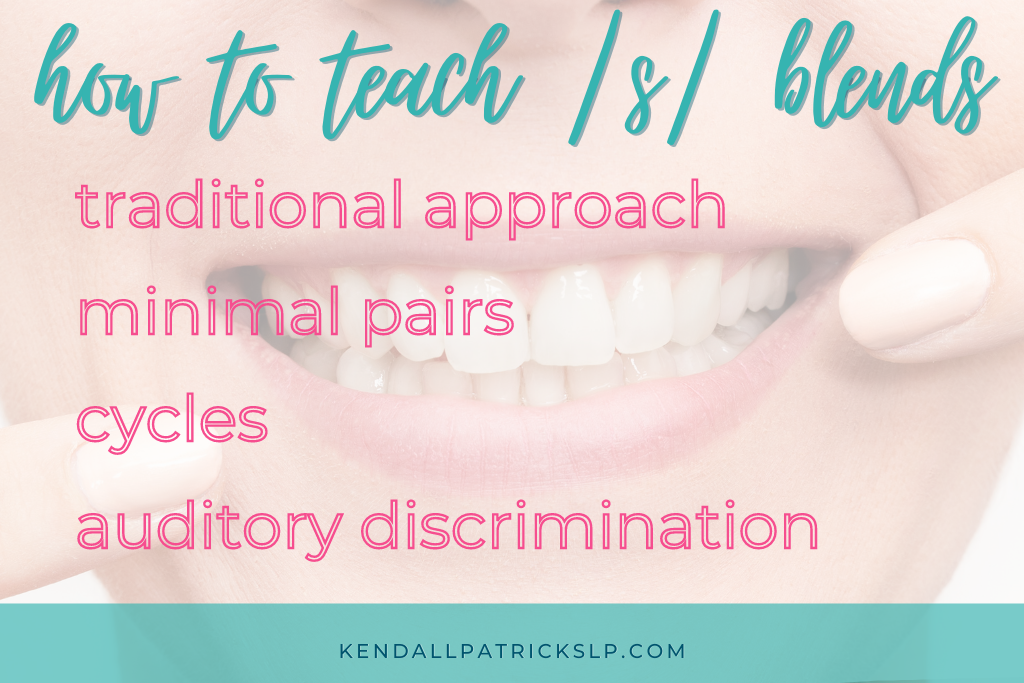
How to Teach S Blends
The traditional approach is commonly used in speech therapy and I use it quite often with a lot of my students. This method refers to the articulation therapy that focuses on one sound at a time and you practice at each level (isolation, word, phrase, sentence, etc.) until mastery is reached and then move on to the next. I use this with my students with just a couple of error sounds, but typically my kiddos working on /s/ blends have multiple phjonological processes. So I don’t really find this approach to be the most effective in these cases.
There is also the minimal pairs approach. I don’t use this one as often, just because I don’t have that much practice with it. (I learned the cycles approach from a mentor and loved the results I saw with it, so it’s usually my first approach). But minimal pairs is highly effective in treating phonological processes as well and is great to pair with other phonemic awareness tasks.
How to Teach S Blends: Speech Therapy Favorites
The Cycles Approach, developed by Barbara Hodson, is an approach in which you target each phonological process for short, fixed amount of time and cycle through other phonological processes. This approach is ideal for children with a lot of error patterns.
Here is what it might look like:
- 1st Week : final consonants
- 2nd Week: final /k/
- 3rd Week: initial /k/
- Weeks 4-10: initial /s/ blends
- Weeks 11-13: final /s/ blends
- Week 14: initial /l/
- Week 15: initial /r/

It can be difficult to move on to the next cycle when you know they haven’t reached mastery, but it is so worth it! You will be amazed at how much progress they will make just after addressing /s/ blends. While it may seem too complex to target those sounds early on, research actually supports targeting the more difficult sounds first. Once they have mastered (or even just made some progress) on those blends, you will see progress in earlier developing sounds as well. I have found that using this approach I don’t even have to target /s/ and /z/ individually as they come along on their own!
Here is what a single session working on an /s/ blend target might look like:
- Auditory Bombardment: SLP orally presents target words (e.g., stew, step, stick, stop, stone) and the student just listens (they do not participate in saying the words).
- Introduce new sounds as “friends.” Example: This is Mr. S and Mr. T. Mr. S was feeling very lonely and wanted a friend, so along came Mr. T. They go on a walk together, but it is very important they stay together!
- Practice sounds with tactile cues: I like to have the student move their finger along the table as they say the /s/ sound and tap as they say the /t/ (as seen below).
- Practice target words (stick to the simpler, 1 syllable words if needed) and repeat with lots and lots of trials.
- Model in phrases and sentences and (if appropriate) have student repeat the modeled phrases/sentences.
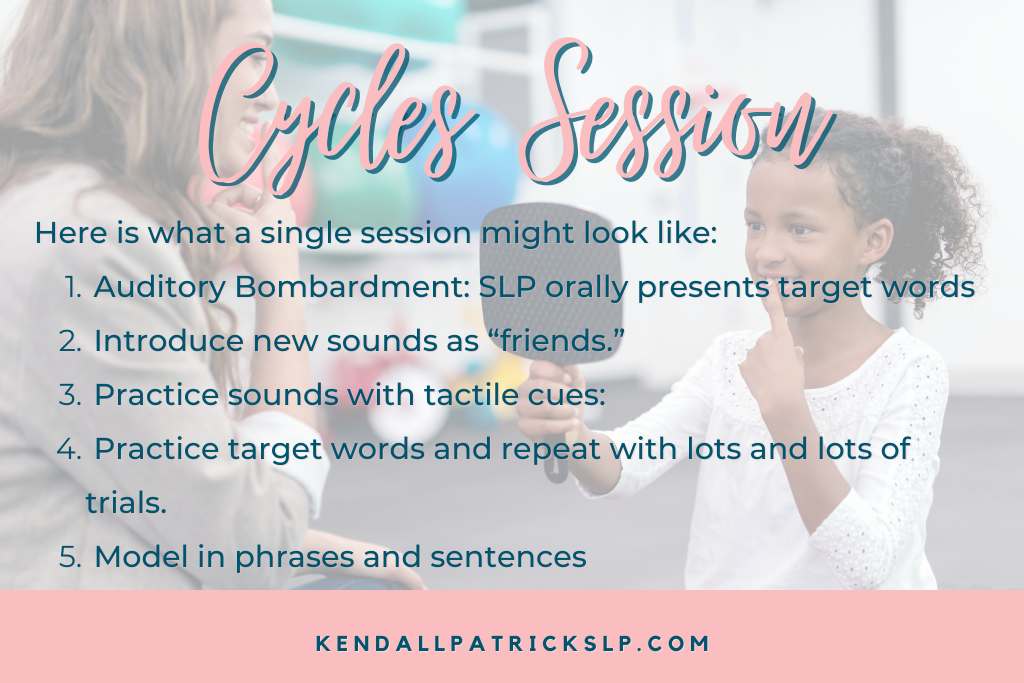
For another great resource, The Peachie Speechie has some great videos on teaching /s/ blends. Check them out here!
S Blends Speech Therapy Games and Activities
There are so many fun and engaging games and activities you can use to work on /s/ blends in therapy.
- Matching games (great for minimal pairs work)
- Books (“Spot” books for /sp/, “That’s not my…” books for /ts/, “Stickman” for /st/, “We’re Going on a Bear Hunt” has a variety, etc.)
- Toss Games (bean bags, balls, bowling)
- Go Fish with arctic cards
- Movement Games (Musical Stepping Stones)
- Interactive Worksheets
*For more books to use in therapy, check out https://booksharetime.com/. You can search for books to use in therapy by langauge goals/targets, age, speech sounds… It really is a great FREE resource!
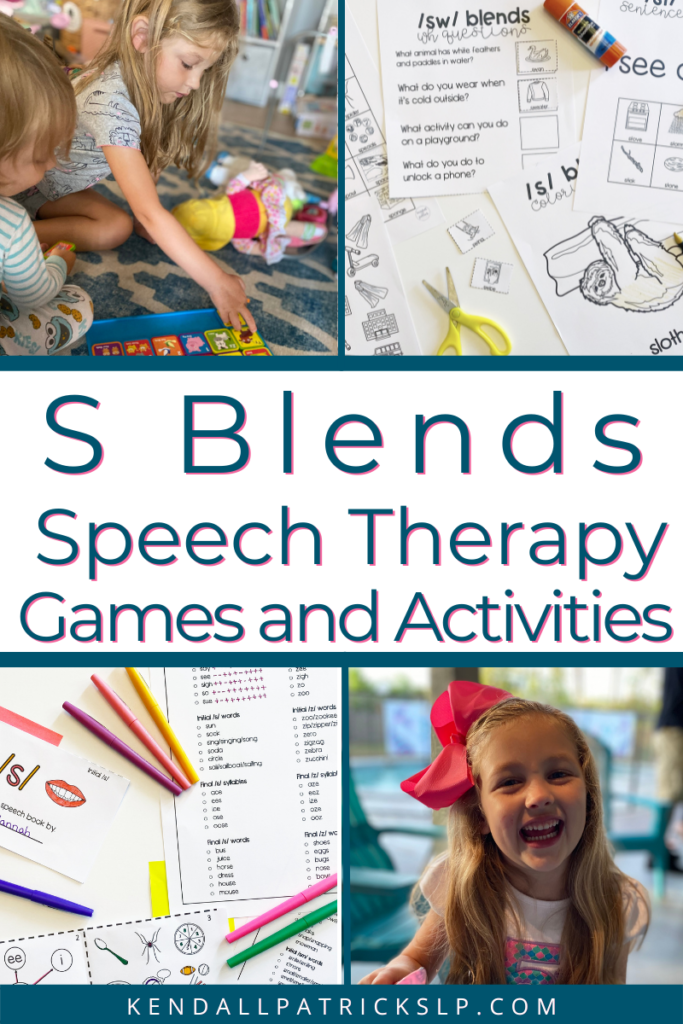
Movement Games
One of my favorite, super-simple go-to activities for those times when you just need to get moving, is a musical stepping stones game!
- First, I put out pictures in a large circle around the room*
- I put velcro on the back of mine because I have carpet squares in my room, but you could do tape too if you have tile (to prevent slipping)
- When the students arrive I have them each stand on a picture
- We review the rules (e.g., no running, no skipping in line, when the music stops, you stop, etc.)
- I start the music!
- When the music stops, they stop on whatever picture they are on/closest to and complete their individual task (say the word or phrase with their target sound, or maybe just practice in isolation)
*Pictures – in this case, I would use /s/ blend pictures
S Blends Worksheets – Speech Therapy Activities
One of my top-selling resources is by /s/ blends worksheets, which tells me you guys are working on lots of /s/ blends!
These one-page speech s-blend worksheets are a simple way to target all initial /s/ blends with multiple trials and very little prep time. These phonological process activities can be used in isolation to target students’ articulation goals or they are also perfect to use within the cycles approach.
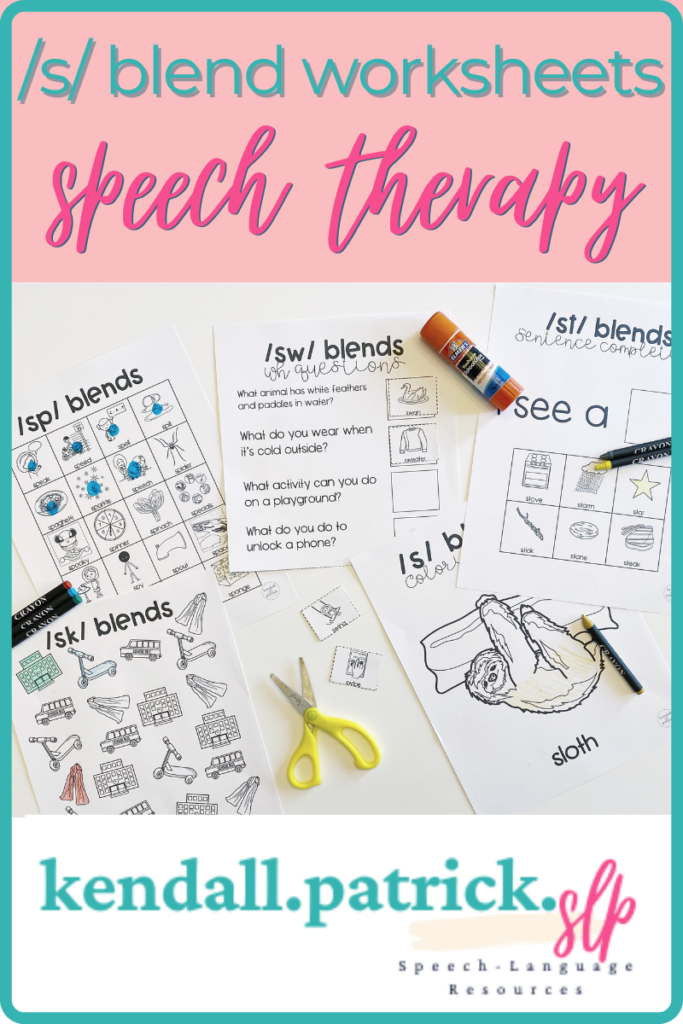
What’s Included:
- Target words for /s/ blends words – /st, sn, sm, sp, sw, sk, sl/
- Coloring pages to use as reinforcers or home practice
- Sentence completion pages
- ”wh” questions
- 7 bonus coloring pages
Tips for Use:
- You can use the target word pages to teach the sound patterns, use for drill/repetition, student coloring pages, or homework
- The reinforcer pages are perfect to use with or without a dice for additional practice
- You can use the sentence completion tasks to target in connected speech
- Use the “wh” questions pages to target language goals while still getting in additional trials for speech targets
- Send copies of any of the pages home for practice with instructions for parents or keep in student folder that goes between school and home
Grab these free /st/ sheets in my free resource library now!
Here are some more /s/ blend speech therapy ideas and activities:
/s/ blend ideas from A Gift of Speech
/s/ blend word lists from Speech Therapy Talk
Free articulation worksheets from Speech Teammate
Don’t forget to check out my freebie library, access it here:
I hope you found some of these s blend speech therapy techniques helpful and can use one or more in your therapy room this school year. Please leave a comment or shoot me an email if you want to share some of your favorite s blend speech therapy ideas!

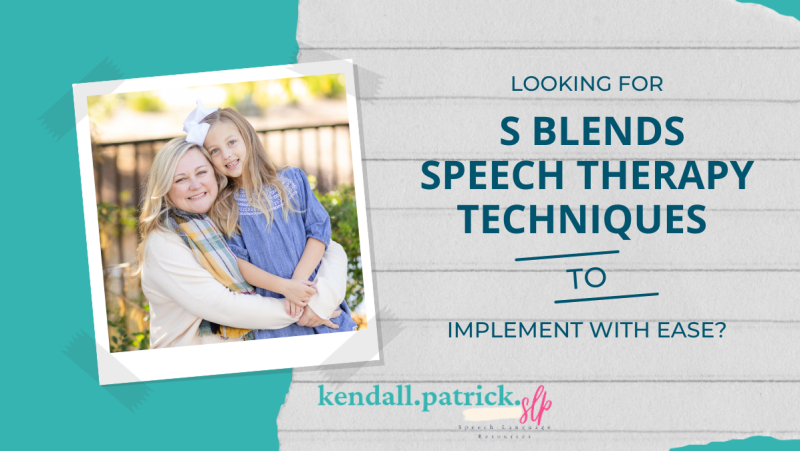

2 Responses